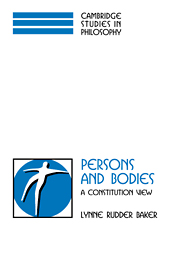4 - The Constitution View of Human Persons
Published online by Cambridge University Press: 05 June 2012
Summary
In ordinary discourse, we speak of people as having bodies without making much fuss about just what this ‘having’ relation is. What does it mean to say that I have a body? The Constitution View offers an answer: For a person to have a body is for the person to be constituted by a body (in the sense of‘constitution’; explicated in Chapter 2). A person is not a separate thing from the constituting body, any more than a statue is a separate thing from the constituting block of marble. Nor is a person identical to the constituting body. The nonidentity of person and body, on the Constitution View, is guaranteed by the fact that any body could exist without a first-person perspective, but no person could exist without a capacity for first-person perspective (in the sense of ‘first-person perspective’ explicated in Chapter 3). Now I shall try to spell out in detail just how human persons are related to their bodies.
WHAT A HUMAN PERSON IS
On the Constitution View, what makes a human person a person is the capacity to have a first-person perspective. What makes a human person a human is being constituted by a human organism.
A first-person perspective is a defining characteristic of all persons, human or not. From a first-person point of view, one can think about oneself as oneself and think about one's thoughts as one's own.
- Type
- Chapter
- Information
- Persons and BodiesA Constitution View, pp. 91 - 117Publisher: Cambridge University PressPrint publication year: 2000
- 1
- Cited by



